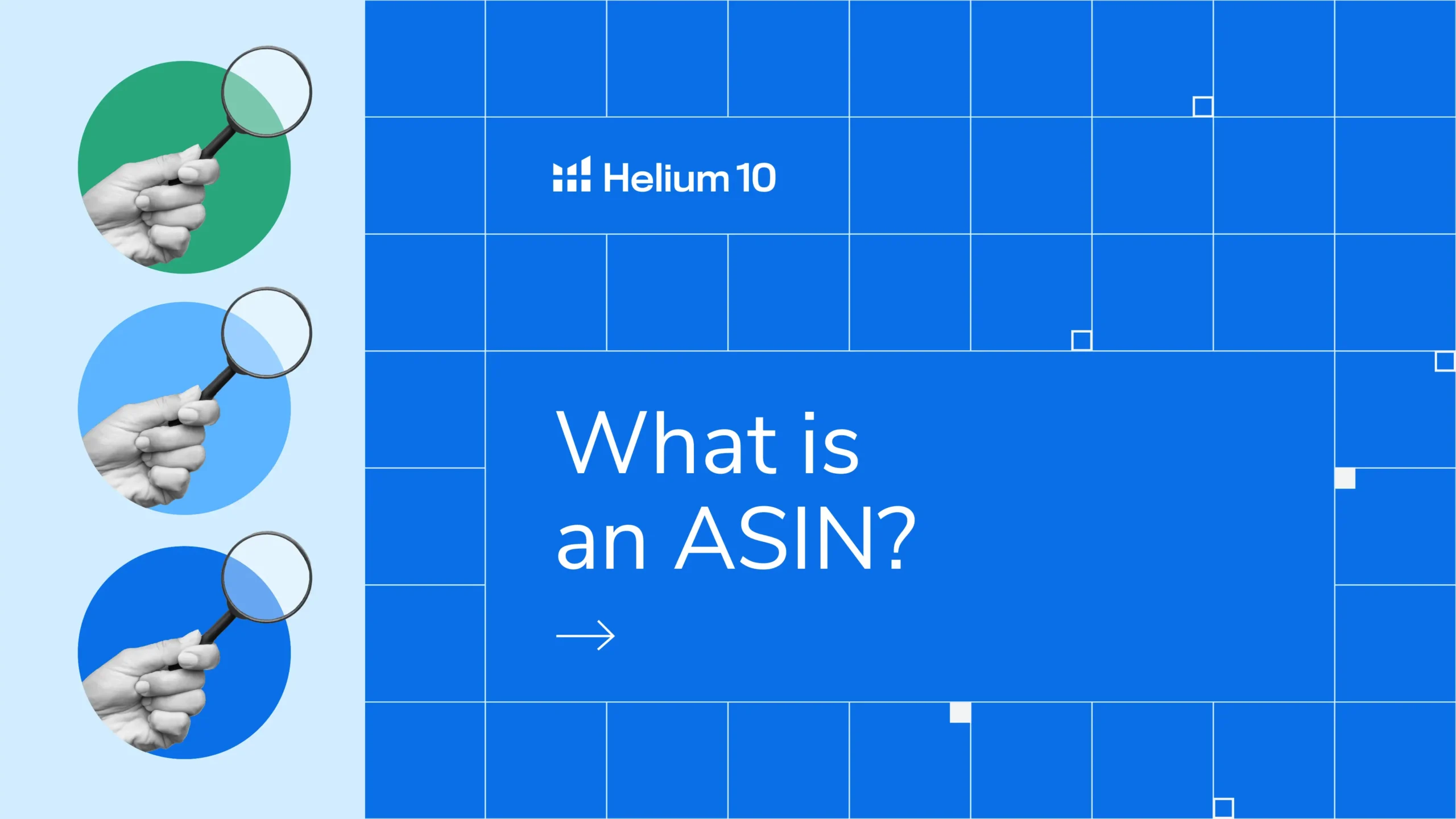
What Is an ASIN & How to Create One


Table of Contents
Introduction
No two fingerprints are the same, not even identical twins.
No matter how much we age and change our appearance, those little lines remain the same. In fact, fingerprints develop before we are even born. It’s no wonder that we use these loops, whorls, and arches for life-long identification!
If you’re selling on Amazon, you need to know your way around the ASIN. It’s your product’s one-of-a-kind fingerprint that helps Amazon catalog, track, and rank your product. It’s also the identification number you will be using to conduct keyword research (both for yourself and when spying on your competitors’ keywords).
We’ve assembled a list of ASIN-related information that you need to know if you are planning on succeeding with Amazon FBA anytime soon.

Outclass Your Competitors
Achieve More Results in Less Time
Maximize your results and drive success faster with Helium 10’s full suite of Amazon and Walmart solutions.
Sign Up for FreeWhat Does ASIN Stand For?
ASIN stands for Amazon Standard Identification Number. This number serves as a unique identifier for every product sold on Amazon which allows the e-commerce site to effectively catalog, track, and manage all the items being sold on their site.
What Is an ASIN?
An Amazon ASIN is a unique series of 10 letters and numbers and is assigned to every product sold on the site, including those on the list of best-selling Amazon items. This code is essential for product identification and helps Amazon manage its billions of products.
When selling books on Amazon, keep in mind that the ASIN is the same thing as an ISBN number. For non-book products, an ASIN will be created as soon as an item is successfully uploaded to Amazon.
Amazon sellers should also keep in mind that ASINs are unique within a specific marketplace. This means that, if you initially start selling a product on Amazon’s US site but switch to Amazon Germany (for example), then you may need to create a different ASIN for that same product.
Why Are ASINs Important?
ASINs are important because they are used to reference catalog data, track product inventory, and index catalog pages for search and browsing purposes by customers on Amazon.
The foundational and highly important ASIN is an integral aspect of Amazon’s internal catalog structure and gives shoppers the ability to:
- Easily search for products by going through multiple categories
- Quickly search for a specific item by typing the ASIN into the search bar
The ASIN is also important for Amazon itself because it allows the site to provide both accurate and relevant product searches for its customers every single time.
With all this being said, it’s crucial that Amazon sellers correctly identify and use ASINs for each of their products. If this is not done—or not done correctly—Amazon will not be able to effectively organize and search for your products. This ultimately leads to fewer sales since your customers won’t be able to locate your product, either.
Finally, if you ever decide to list a product on Amazon, it is vital that you match your new product to an existing ASIN or create a brand-new one.
How to Find an ASIN on Amazon
There are a few ways that you can find an ASIN for one of your products on Amazon:
- By using your product’s web address on Amazon
- By using your product’s details on Amazon
- By using a third-party tool designed to look up ASINs on Amazon
However, the quickest way to look up your ASIN is to simply check your browser or search engine’s URL bar at the top of the screen. If you’re currently on your product listing, the ASIN number will be after your product’s name and “dp”. An example of this is shown below.
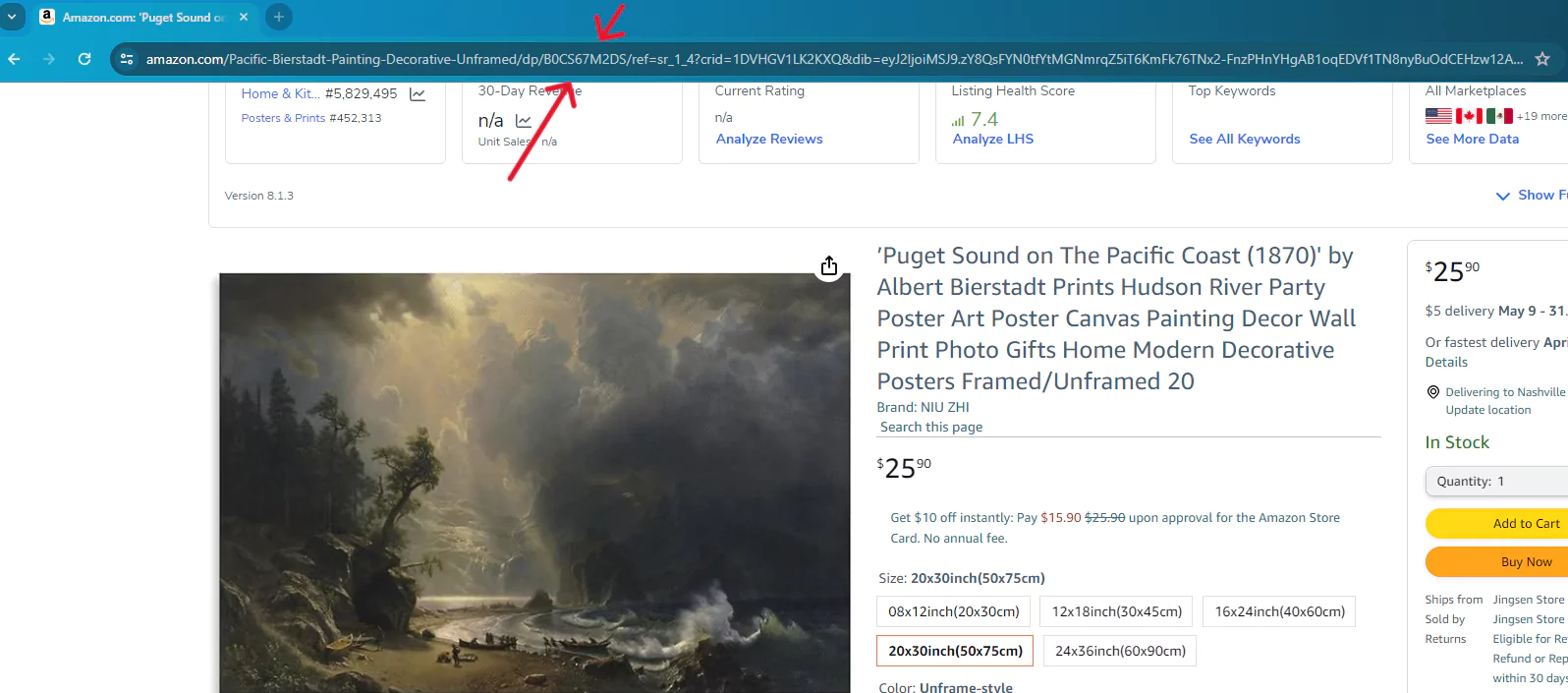
In the above image, the ASIN is “B0CS67M2DS”.
If you do not want to use the above method, you can alternatively find your ASIN number within the “product information” section below your product listing.

A final way to find an ASIN on Amazon is to utilize a software tool. This can be a good idea if you currently have thousands of ASINs, making it both tedious and time-consuming to look up ASINs one by one.
Save time you can use to work on other aspects of your brand by using the Helium 10 Chrome Extension tool. This browser extension contains a completely free and intuitive Amazon ASIN grabber tool that allows you to search for ASINs in the blink of an eye, saving you a huge amount of time you can then use to invest in other aspects of your growing business.
A final thing to note here is that you are prohibited from creating a new ASIN for an already existing product on Amazon. If you ignore this rule and create a new ASIN anyway, you run the risk of a temporary Amazon suspension of your selling privileges or a permanent removal from selling on the site entirely.
To avoid this catastrophic event that can potentially sink your business, be sure to check if your item is already on Amazon.
How to Create an ASIN for Amazon
Whenever you decide to add a new product to Amazon, you’ll need to create a new ASIN as well. This will ensure that your product is included in the Amazon catalog. If you’re the manufacturer of your product, you’ll also need to add an ASIN for each individual item you have on the e-commerce site.
To create a brand new Amazon ASIN, Amazon lets you use the handy “Add a Product” tool. If your ready-to-be-sold item already exists on Amazon, this tool will immediately match it up with the correct ASIN. If, however, it’s a net-new product, you’ll be required to create a new ASIN.
It’s important to remember that, if you add a new ASIN for your product, other sellers can also use the same ASIN to sell copies of your item.
Additionally, when creating a new ASIN on Amazon, you’ll need to have a thorough understanding of your product’s GTIN (Global Trade Item Numbers). In most cases, the GTINs you’ll be using will be Amazon UPCs, ISBNs, and EANs. These specific product codes are commonly located near the barcode located on your product’s packaging. Furthermore, Amazon utilizes these important universal product identifiers to create and match their own ASIN codes.
Here’s a quick breakdown of these 4 codes:
- ISBN (International Standard Book Number): 10 digits or 13 digits
- UPC (Universal Product Code): 12 digits
- EAN (European Article Number): 13 digits
- GTIN-14 (Global Trade Item Number): 14 digits
If you currently do not know what your product’s GTIN number is, you can easily request it directly from the product manufacturer. However, if you manufactured your Amazon product yourself, then you’ll need to take additional steps to register your product via the GS1 for United States UPCs, or the US ISBN Agency for (you guessed it) ISBNs.
Please note that the GS1 and US ISBN Agency may not apply if you’re a non-US seller.

What Is an ASIN Reverse Lookup Tool, and Why Should I Use One?
ASINs can be used to easily track your competitors on Amazon. By taking the time to research your competitors’ ASINs, you can put yourself in a better position that will help you raise your products’ organic and advertising Amazon rankings, as well as learn which long-tail keywords you should be targeting on both an organic and PPC level.
This process, called a reverse ASIN lookup, can be done using the Helium 10 software tool, Cerebro.
By using this powerful Amazon keyword tool, you can boost the chance that your new product launch will be successful and promote increased awareness of your brand. This is crucial for any serious Amazon seller, and it can all be done when using your competitors’ keywords against them to eventually outrank them on the site.
To use this tool, simply plug in a competitor’s ASIN in the top search bar.
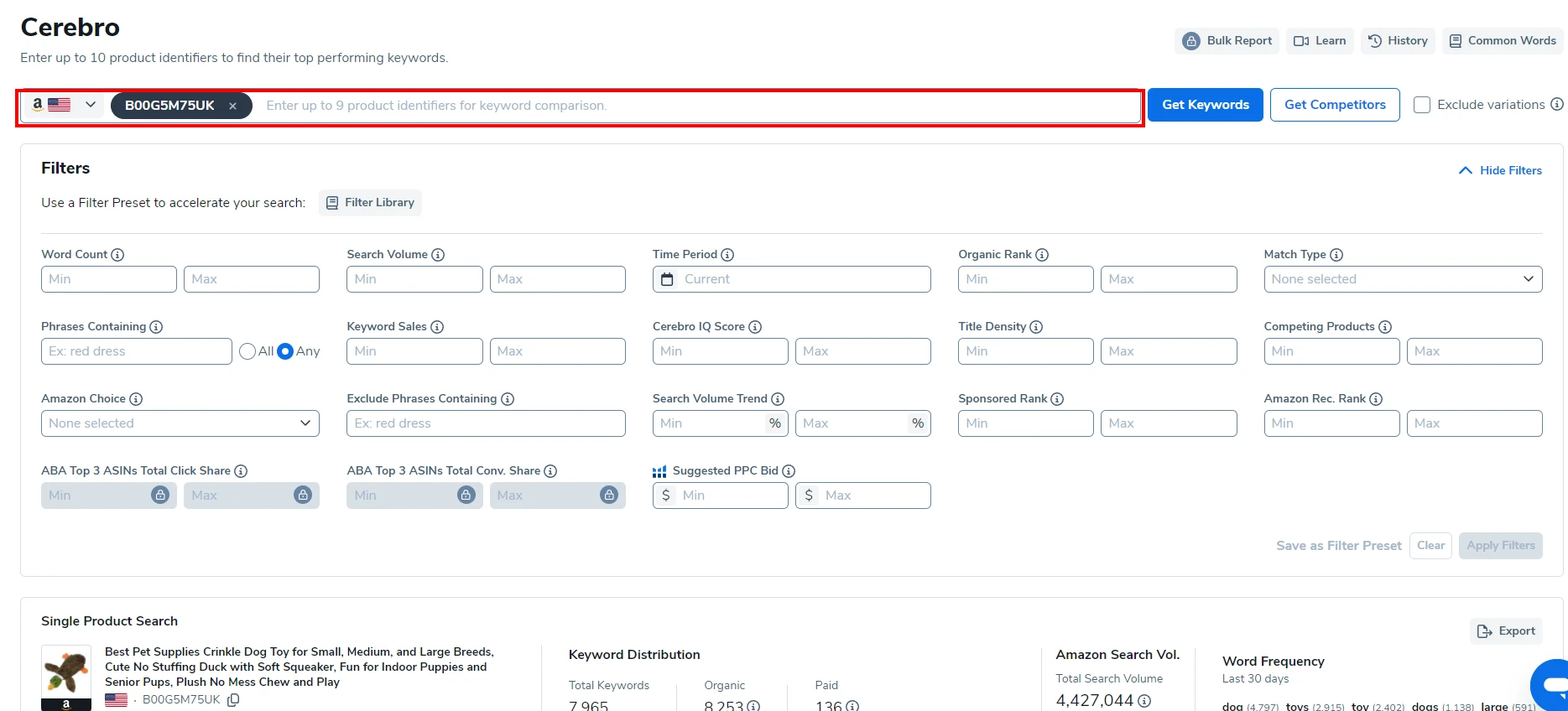
Next, tweak the below filters—including the word count and search volume—to quickly discover your competitor’s top-performing keywords which you can use in your own listing to outrank them.
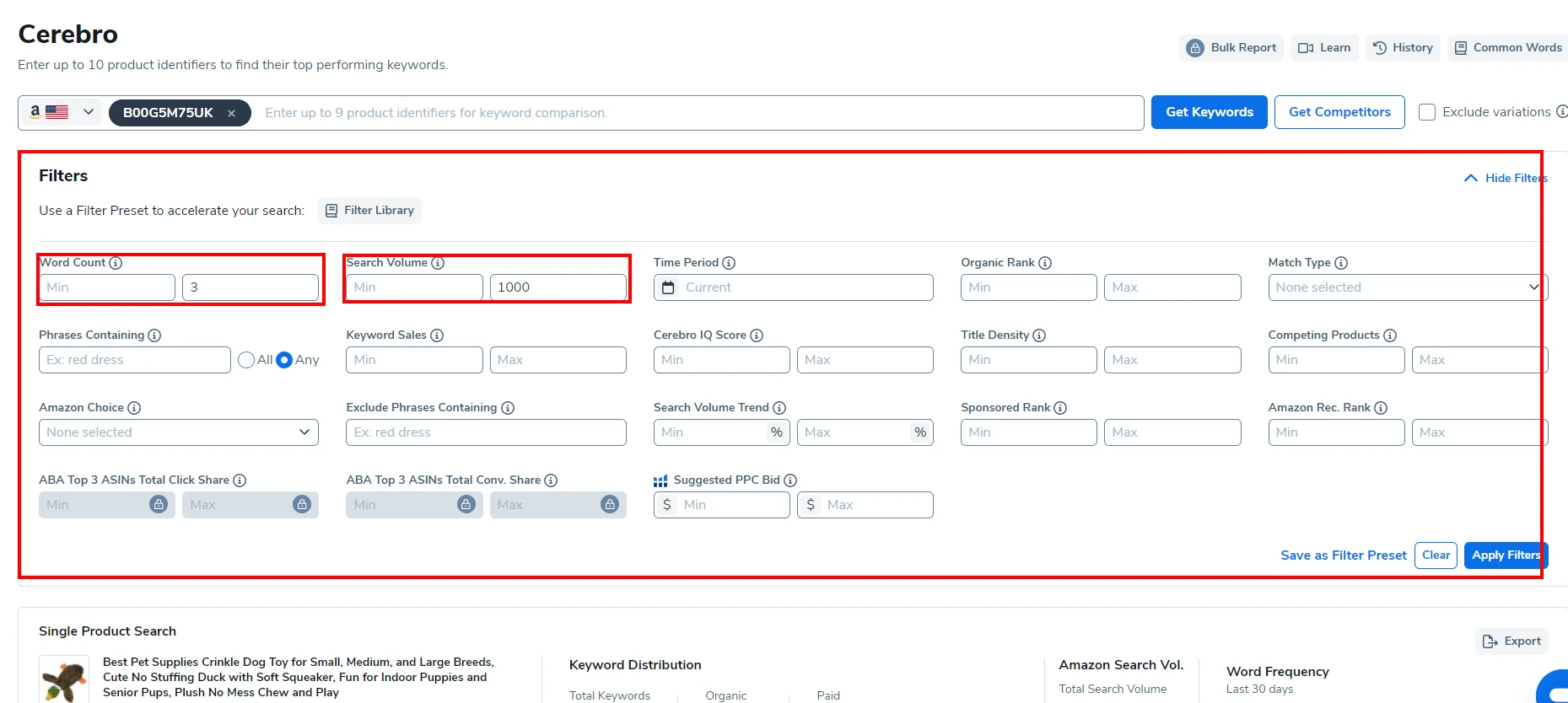
Now, you will see a list of potentially thousands of competitive keywords you can add to your own Amazon listing.
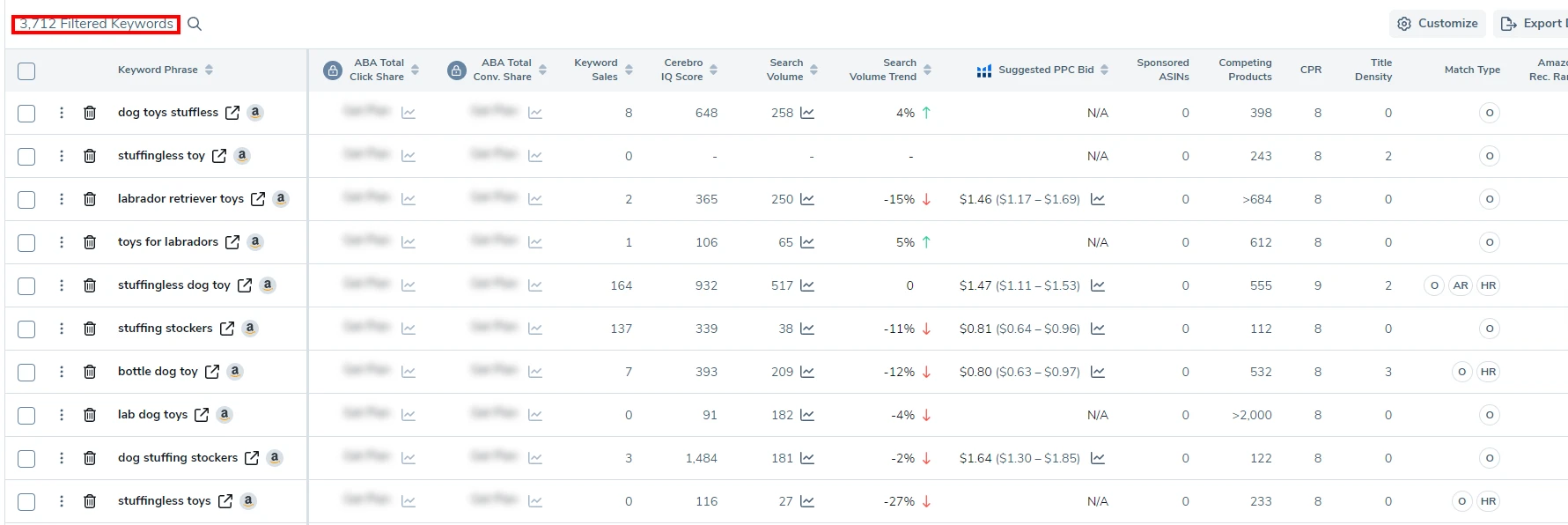
By carefully using Cerebro to find winning Amazon keywords, you can help ensure that each one of your products is as profitable as possible, giving you a significant boost to your selling game.
Conclusion
It’s important to remember that an ASIN is more than just an identification number. In a lot of ways, it’s the code to unlocking product and keyword data for virtually any product on Amazon. And now you know how to find it!
Frequently Asked Questions
Achieve More Results in Less Time
Accelerate the Growth of Your Business, Brand or Agency
Maximize your results and drive success faster with Helium 10’s full suite of Amazon and Walmart solutions.

